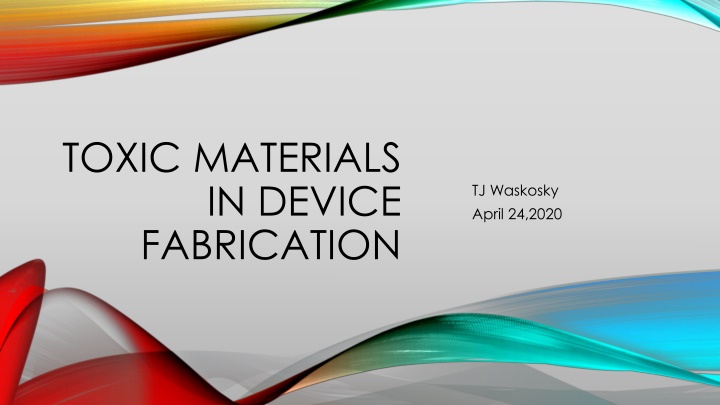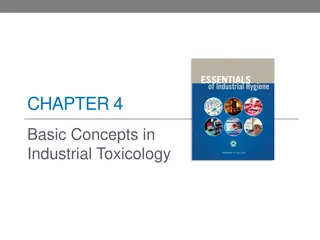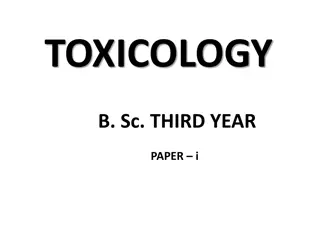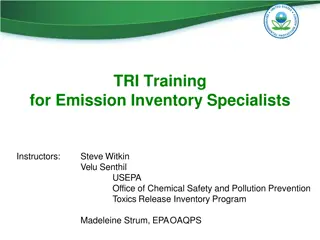Effects of Toxic Materials in Device Fabrication and Environmentally Friendly DSSC Options
Negative effects of toxic materials used in device fabrication processes include reproductive health issues, cancer risks, and respiratory abnormalities for workers. Dye Sensitized Solar Cells (DSSC) present a more cost-effective and simpler alternative to silicon solar cells, with metal sensitizers like Ru(II) and Os(II) being efficient but unsustainable. New dyes like N3 are being explored for improved energy conversion efficiency.
Download Presentation

Please find below an Image/Link to download the presentation.
The content on the website is provided AS IS for your information and personal use only. It may not be sold, licensed, or shared on other websites without obtaining consent from the author.If you encounter any issues during the download, it is possible that the publisher has removed the file from their server.
You are allowed to download the files provided on this website for personal or commercial use, subject to the condition that they are used lawfully. All files are the property of their respective owners.
The content on the website is provided AS IS for your information and personal use only. It may not be sold, licensed, or shared on other websites without obtaining consent from the author.
E N D
Presentation Transcript
TOXIC MATERIALS IN DEVICE FABRICATION TJ Waskosky April 24,2020
HARMFUL EFFECTS OF FABRICATION CURRENT USE OF DSSC ENVIRONMENTALLY FRIENDLY DSSC OPTIONS OUTLINE SUMMARY REFERENCES KEY CONCEPTS
Material deposition Photolithography Etching Doping Processes for wafer fabrication include WAFER FABRICATION All Processes include varieties of chemicals Organic solvents Acids Metals
Some of these chemicals are just mild irritants to the skin. Some of them are more serious and are carcinogens, reproductive toxins, and neurotoxins. EFFECTS OF CHEMICALS Most facilities have systems that are recirculating the air which makes the workers more vulnerable to the chemicals. These chemicals are bad on their own but can be made worse if they get a chance to combine.
CHEMICAL EFFECTS Negative effects were observed regarding: reproductive health, cancer, and respiratory abnormalities. Reproductive Health Was shown to effect both men and women working in the plants, more apparent for people directly involved in the fabrication process. Cancer Many studies suggest that there is an elevated risk of Brain, liver, breast cancer as well as leukemia. Respiratory abnormalities Male fabrication workers are 4 times more likely to have experienced a pulmonary abnormality
DYE SENSITIZED SOLAR CELL Dye sensitized solar cells (DSSC)are starting to become more popular over silicon solar cells because they cost less to create and are simpler. The structure consists of Wide band gap semiconductor Dye sensitizer anchored on top Redox mediator Redox couple And a glass substrate
Bind strongly to TiO2 High Molar Absorption coefficient REQUIREMENTS FOR THE DYES Faster electron transfer rate Higher energy level than conduction band of TiO2
METAL SENSITIZERS Some of most efficient dye sensitizers that have been discovered are Ru(II)[Ruthium] and Os(II)[Osmium]. These two metals are rare and makes wide scale production unsustainable. New dyes were looked into and now N3 dye is the standard as a metal compound. The N3 dye has an electrical energy conversion efficiency of 10% and absorption band covers most of the visible spectrum. Even though metal sensitizers are highly efficient they have their draw backs. Release toxic chemicals Long synthesis and purification steps High production cost
ORGANIC SENSITIZERS Organic sensitizers provide a few benefits it is easier to modify the structure which can increase the efficiency of DSSC, and the extinction coefficient is considerably higher. The general design of a metal-free organic sensitizer is a donor-acceptor- substituted -conjugated bridge Usually have an ECE between 4-9%
ORGANIC SENSITIZERS Organic sensitizers also have some major draw backs Reduced electron injection to the conduction band. Smaller absorption bands Low stability Dyes themselves could be toxic By products act as environmental pollutants Long and tedious purification process
NATURAL SENSITIZERS With the drawbacks of the metal and organic sensitizer dyes work is being done to look for natural dyes and pigments to be used instead. The natural dyes have benefits of Complete biodegradation High availability High purity Environmentally friendly Low production cost Easy access
NATURAL PIGMENTS There are multiple classes of the natural dyes 4 of the most common are Carotenoids Have C40polyene backbone Contributes to red, orange, and yellow colors. ECE 2.6% Flavonoids C6-C3-C6carbon framework Most flavonoids can be excited by visible light range Loosely bound electrons
NATURAL PIGMENTS Chlorophyll Absorbs red, blue and violet wavelengths Creates strong bond withTiO2 Anthocyanin Most abundant pigment type Absorb light at longest wavelengths ECE <1%
FINAL COMPARISON The natural dyes tend to have a lower ECE when compared to the metal compound of organic dyes. This can be made up for my combining some of them chlorophyll and carotenoids can get to an ECE around 5% when combined. The cost of the dye is almost negligible when compared to metal complexes or organic dyes. Overall cost is even less for chlorophyll as the dye.
SUMMARY The fabrication of semiconductors can cause serious health issues for those who work on producing them as well as those who leave near the facilities due to the waste products. One area where research is starting to become more friendly to the environment is in the creation of DSSC. The natural pigments are safe for the environment and cheaper and easier to use but just lack the efficiency of the other options.
REFERENCES "Researchers from Seoul National University Report Findings in Occupational and Environmental Health (The health impacts of semiconductor production: an epidemiologic review)." Health & Medicine Week 18 July 2014: 4133. Business Insights: Essentials. J. Harland, T. Reichelt and M. Yao, "Environmental sustainability in the semiconductor industry," 2008 IEEE International Symposium on Electronics and the Environment, San Francisco, CA, 2008, pp. 1-6. Harland, J., T. Reichelt, and M. Yao. "Environmental Sustainability in the Semiconductor Industry." 2008 IEEE International Symposium on Electronics and the Environment, 2008, 1-6. https://www.ncbi.nlm.nih.gov/pmc/articles/PMC4090871/
KEY POINTS The chemicals used in device fabrication are toxic to those working with them. The waste products of device fabrication also hurts the environment and people who live in the area. DSSC started out by using rare metals that provide a higher ECE but cost more and were toxic. Natural pigments are non-toxic alternatives that are being looked at as more sustainable options Natural pigments can even be cheaper to produce even though they are less efficient.





















